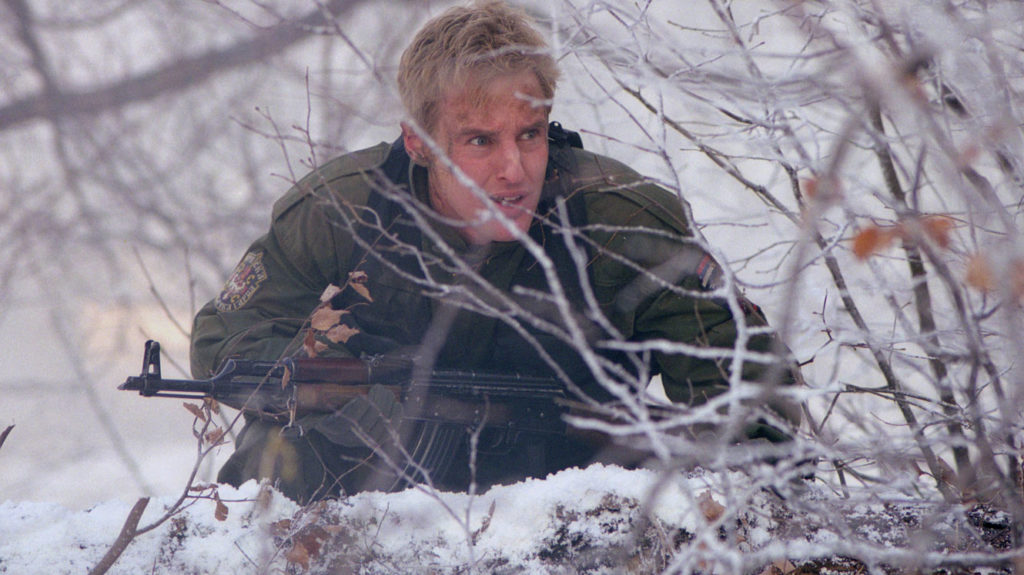
Adrenaline junkies who lack the attention span required for a cerebral thriller like Spy Game now have their own geopolitical actioner for the 2001 holiday season, the spastically filmed and frenetically edited Behind Enemy Lines. Chris Burnett has spent seven years in the Navy waiting to see “real” military action. Currently stationed on an aircraft carrier in the Adriatic Sea, he’s frustrated about policing skirmishes he can’t understand, and tells his commanding officer, “I signed up to be a fighter pilot. I didn’t want to be a cop walking a beat nobody cares about. We’re not fighting; we’re watching.” He’s about to walk away from the military when, during a final reconnaissance mission, Burnett and his pilot violate a no-fly zone and snap pictures of some things no one was meant to see. The bad guys fire heat-seeking missiles (I’ve never seen a movie get more mileage out of one plane going down) and the men eject. On the snow-covered ground they must contend with a devious tracker, a ruthless secret police enforcer and a tenacious army equipped with heavy artillery. And they’re taking no prisoners. It’s a game of survival until help arrives, assuming Admiral Reigart can out-shank a political strategy that puts a pending peace treaty ahead of Burnett’s life.
positive elements: Reigart and others nobly put their safety and careers at risk to save a colleague. One serviceman reminds a frustrated Burnett that “everybody has a role to play” in their mission. Burnett risks his own life to retrieve photos proving that the army pursuing him is guilty of genocidal atrocities, in part to make sure his partner’s death was not in vain. Local rebels offer kindness (a ride and a Coca-Cola) to Burnett while he’s on the run. By the end of the film, the young lieutenant learns to respect the distant, faceless global struggles he previously held in contempt.
sexual content: None.
violent content: War violence is rampant. Burnett and Stackhouse have their plane destroyed, though both manage to escape and parachute to earth. Stackhouse suffers a bloody, broken leg which prohibits him from escaping when the bad guys roll in. He is interrogated and then shot in the head at close range. A vicious sniper targets Burnett throughout. Tanks, machine guns, landmines, trip-wires and other instruments of destruction take their toll. Many buildings get devastated and the body count mounts. An officer steps on a mine and we hear him blow up. Burnett slogs through a muddy mass grave, climbing over severed body parts (there’s a flashback to how those bodies got there, as common folk are lined up and mowed down by a firing squad, then beaten to pieces). The police enforcer angrily unloads a pistol into an already-dead body. The driver of a pickup truck gets shot through the windshield before the vehicle flips over. A final showdown between Burnett and the sniper tracking him involves both men shooting each other and beating each other bloody before the young American stabs his enemy in the chest with a signal flare. U.S. choppers and Bosnian ground troops exchange fire, which leaves the snow littered with bodies.
crude or profane language: More than 40 profanities, including one f-word, a dozen misuses of the Lord’s name, 13 s-words and an obscene gesture.
drug and alcohol content: None.
other negative elements: Not so much “negative” as sobering. A young civilian who assists Burnett expresses a love for Western rap and hip-hop music, specifically Ice Cube and Public Enemy. It’s a sad reminder that the violent entertainment we ship abroad colors the way our society is perceived by those who haven’t experienced America first-hand.
conclusion: Behind Enemy Lines is a chaotic testosterone-fest that will briefly satisfy the visceral appetites of young American males wanting fewer talking heads on CNN and more Gulf War-style photos of midnight bombing raids. Jingoistic patriotism reigns, seeming all the more juvenile in light of current events. The film is loud and busy. That volume and visual energy stands in for realistic dialogue and believable scenarios. In a few scenes, Wilson is pinned down in seemingly impossible situations. The next thing we see is our fair-haired boy running through a forest or field with no explanation of how he managed to escape being picked off by his sneering pursuer, who has to be the worst “crack-shot” sniper in the hemisphere. It all makes Top Gun seem downright poignant.
John Moore is best known in the industry for his effects-heavy television spots for Adidas, Guiness and—big surprise—SEGA. So is it any wonder that Behind Enemy Lines often plays like a commercial, or a video game, or a commercial for a video game? What Moore intends as visual style seems more like a kid testing out all the special gizmos on a new high-tech video camera after downing a six-pack of Jolt cola. It’s a mindless popcorn flick in the truest sense. Of course, some viewers demand nothing more for their seven or eight dollars. But even among those thrill-seekers, a sizable number would rather not have to avoid the trip-wires of language and violence that, in this case, take full advantage of the limits of the PG-13 rating.
